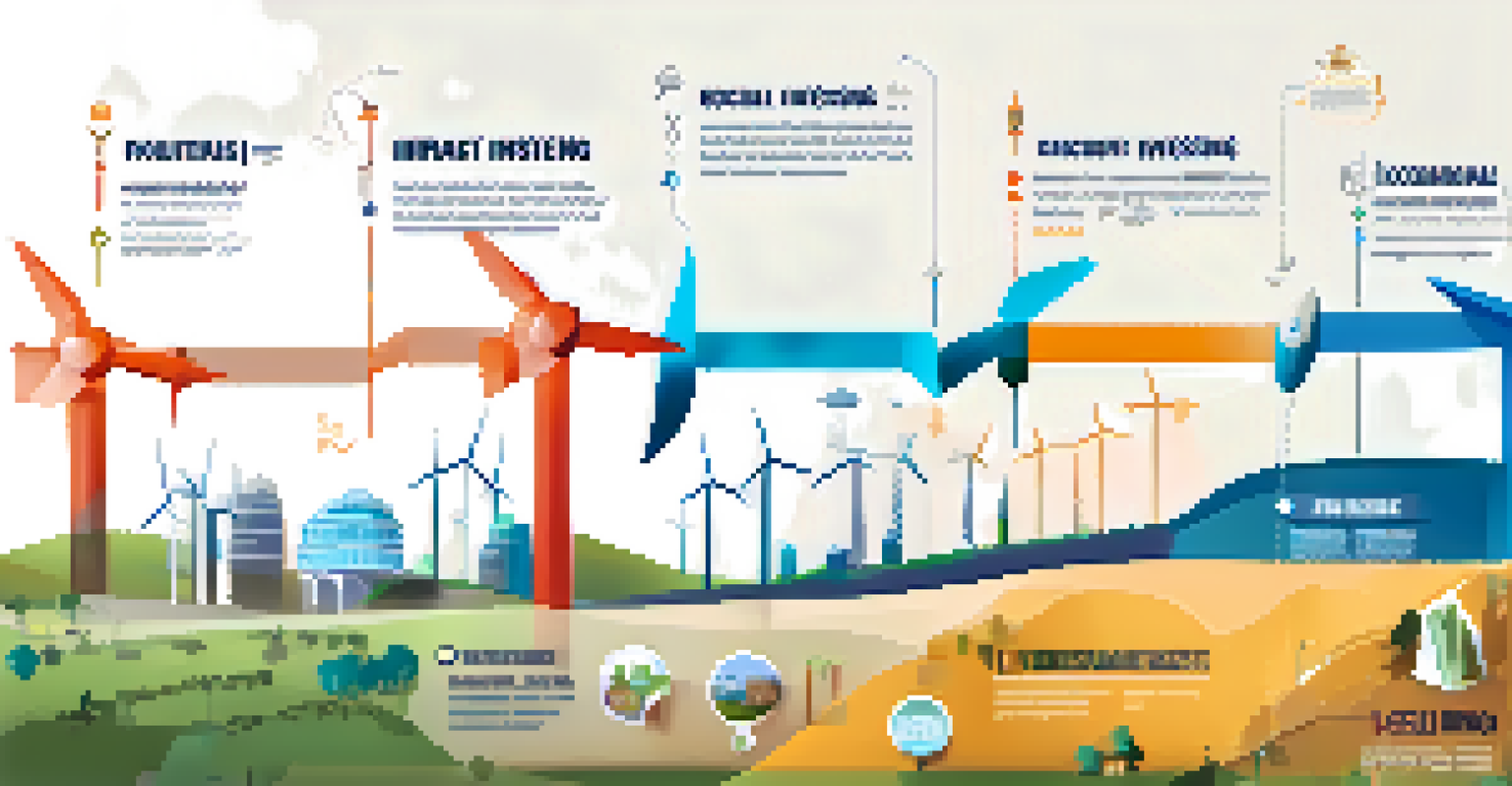Impact Investing vs. Traditional Investing: Key Differences

Understanding Impact Investing: A Brief Overview
Impact investing focuses on generating social and environmental benefits alongside a financial return. Unlike traditional investing, which primarily emphasizes profit, impact investing seeks to create a positive impact on society. This approach attracts investors who are passionate about making a difference in areas like renewable energy, education, and healthcare.
Impact investing is a powerful way to drive social change while generating financial returns.
For instance, an investor might fund a startup that provides affordable solar energy solutions to underserved communities. Here, the goal is not only to earn a return but also to help reduce energy poverty. Such investments illustrate how finance and social responsibility can go hand in hand.
In recent years, the popularity of impact investing has surged, as more individuals and institutions recognize the potential for their investments to drive change. This growing interest reflects a broader shift toward sustainable and responsible investing practices.
Traditional Investing: Goals and Objectives
Traditional investing typically prioritizes financial returns above all else. Investors in this space focus on maximizing profits, often using metrics such as return on investment (ROI) to evaluate success. This approach is rooted in the belief that maximizing shareholder value is the primary objective of any investment.

For example, an investor might choose to purchase shares in a company solely based on its historical performance and future earnings potential. In this case, social impact plays little to no role in the decision-making process. The emphasis is squarely on financial gain.
Impact vs. Traditional Investing
Impact investing aims to generate social and environmental benefits alongside financial returns, contrasting with traditional investing's focus on profit maximization.
While traditional investing can lead to significant wealth accumulation, it may also contribute to social and environmental challenges. As a result, some investors are beginning to question the sustainability of this approach in a world facing pressing issues like climate change and inequality.
Key Differences: Financial Returns vs. Social Impact
One of the most significant differences between impact investing and traditional investing lies in their objectives. Traditional investors primarily seek profit maximization, often disregarding the social implications of their investments. In contrast, impact investors prioritize both financial returns and measurable social benefits.
The greatest risk is not taking one. In a world that is changing really quickly, the only strategy that is guaranteed to fail is not taking risks.
For instance, while a traditional investor might choose to invest in a fossil fuel company for its high returns, an impact investor would likely avoid such options due to their environmental consequences. This fundamental difference shapes the investment landscape, leading to diverse choices based on values.
Ultimately, the choice between the two approaches reflects personal values and priorities. Investors must consider what they want their money to achieve, whether it's financial gain, social good, or a blend of both.
Investment Strategies: Different Approaches
Impact investors often employ strategies that align with their social and environmental goals. This might include investing in social enterprises, green bonds, or funds focused on sustainable development. These strategies aim to create a measurable impact while also delivering financial returns.
On the other hand, traditional investors typically follow a more conventional strategy focused on market trends and financial metrics. This might involve investing in blue-chip stocks or index funds, relying on historical performance and economic indicators to guide decisions.
Diverse Investment Strategies
Impact investors often employ strategies like green bonds and social enterprises, while traditional investors focus on market trends and historical performance.
The contrast in strategies highlights the diverse motivations behind investment choices. Understanding these differences can help investors align their portfolios with their personal values and objectives.
Risk Assessment: Evaluating Different Factors
When it comes to risk assessment, traditional investors often focus on financial metrics and market trends. They analyze factors such as volatility, market capitalization, and historical performance to gauge the potential risks of their investments. This data-driven approach helps them make informed decisions aimed at minimizing financial loss.
In contrast, impact investors must also consider the social and environmental risks associated with their investments. For example, they may evaluate how a company’s practices affect its community or the environment, adding another layer of complexity to their risk assessments.
This broader perspective on risk can lead to different investment outcomes and priorities. Understanding the nuances of risk in both approaches is crucial for making well-rounded investment choices.
The Investor's Role: Active vs. Passive Participation
Impact investors often take a more active role in their investments, seeking to influence the companies or projects they support. This might involve providing mentorship, resources, and guidance to help drive social change and improve outcomes. Their engagement reflects a commitment to not just financial returns, but also creating a lasting impact.
Conversely, traditional investors may adopt a more passive approach, focusing primarily on financial performance. They might buy and hold stocks without actively engaging with the companies they invest in. This strategy can be efficient but may overlook opportunities for positive influence.
Evolving Investment Landscape
As awareness of social issues grows, the investment landscape is shifting, with traditional investors increasingly integrating sustainability into their strategies.
Understanding the level of involvement that aligns with one’s investment philosophy can help guide decisions. Whether seeking to make a difference or preferring a hands-off approach, investors must choose the path that resonates with their values.
Future Trends: The Evolving Investment Landscape
The investment landscape is continuously evolving, with impact investing gaining traction among a diverse range of investors. As awareness of social and environmental issues grows, more people are looking to align their investments with their values. This shift indicates a future where impact investing could become more mainstream.
Moreover, traditional investors are beginning to recognize the importance of sustainability in their investment strategies. They are increasingly integrating environmental, social, and governance (ESG) factors into their decision-making processes. This trend suggests a blending of traditional and impact investing approaches.

As these shifts unfold, the lines between impact investing and traditional investing may blur, leading to a more holistic approach to finance. Investors who embrace this evolution can help shape a more sustainable future while still achieving their financial goals.